| PRESENTING THE GREATEST EYEBALL MONSTERS OF ALL TIME. |
As our window to the world around us, the eye is the most important tool in conveying the personality and
emotions of any character in any artistic medium; they are the one feature our minds are always watchful for
and immediately drawn to, a feature by which we tend to gauge the entire personality and mood of another
figure. When it comes to monsters, every detail can make or break the effectiveness of a design, whether
those details are "bulging and bloodshot", "narrow and predatory" or "what eyes?"
Naturally, one of the most prevalent and effective tactics in constructing a "weird" creature is to focus on the
eye as the predominant, distinguishing feature, and monsters consisting primarily - or entirely - of ocular orbs
can be found in virtually any franchise where monsters are a consistent plot device.
Behold, with your two tiny, measly sight organs, some of the most popular, distinctive or just plain neat
eye-creatures that my opinions have picked out from popular culture!
emotions of any character in any artistic medium; they are the one feature our minds are always watchful for
and immediately drawn to, a feature by which we tend to gauge the entire personality and mood of another
figure. When it comes to monsters, every detail can make or break the effectiveness of a design, whether
those details are "bulging and bloodshot", "narrow and predatory" or "what eyes?"
Naturally, one of the most prevalent and effective tactics in constructing a "weird" creature is to focus on the
eye as the predominant, distinguishing feature, and monsters consisting primarily - or entirely - of ocular orbs
can be found in virtually any franchise where monsters are a consistent plot device.
Behold, with your two tiny, measly sight organs, some of the most popular, distinctive or just plain neat
eye-creatures that my opinions have picked out from popular culture!
Sharing a slot because they're almost identical, Vitreous and Ovnunu are two very memorable boss-battles
from two completely unrelated video game classics on the Super Nintendo. Is the latter an homage to the first,
or is there a cultural reference at work here, too obscure even for I?
Vitreous (right) appears in one of the most celebrated console games of all time, The Legend of Zelda: A Link
to the Past, and is encountered in the Dark World's Misery Mire. Ovnunu, on the other hand, is a hidden boss
in the breathtakingly detailed, epic adventure title "Demon's Crest," the subject of one of my very oldest
web pages. Both monsters consist of a giant, central eye and many smaller eyes suspended in a mass of
green protoplasm, and both send out their smaller eyes to float around the room. These monsters unleash
their central eyes for only their last-ditch attack, and here alone is where the two bosses differ. Ovnunu's
lidded, tentacled core is capable of flight and can squirt a stream of acid from the center of its pupil. Vitreous,
on the other hand, has a simple naked orb that bounces like a basketball and fires lightning. It's like apples
and oranges with these two, I swear.
from two completely unrelated video game classics on the Super Nintendo. Is the latter an homage to the first,
or is there a cultural reference at work here, too obscure even for I?
Vitreous (right) appears in one of the most celebrated console games of all time, The Legend of Zelda: A Link
to the Past, and is encountered in the Dark World's Misery Mire. Ovnunu, on the other hand, is a hidden boss
in the breathtakingly detailed, epic adventure title "Demon's Crest," the subject of one of my very oldest
web pages. Both monsters consist of a giant, central eye and many smaller eyes suspended in a mass of
green protoplasm, and both send out their smaller eyes to float around the room. These monsters unleash
their central eyes for only their last-ditch attack, and here alone is where the two bosses differ. Ovnunu's
lidded, tentacled core is capable of flight and can squirt a stream of acid from the center of its pupil. Vitreous,
on the other hand, has a simple naked orb that bounces like a basketball and fires lightning. It's like apples
and oranges with these two, I swear.
| #10 - Vitreous & Ovnunu |

| #9 - Eyeguy |
In 1993, nearly every American male between one and twelve years old was downright ravenous for "Mighty
Morphin' Power Rangers," a live-action children's show that took Japan's "Super Sentai" and remixed it with a
low-budget teen dramedy. In every episode (of either show,) the color-coded heroes hopped aboard their
robot "dinosaurs" (if a you can count a Mammoth, Sabertoothed Tiger or Pterosaur) to tackle a different
monster summoned by a menacing witch who lived on the moon. One of the earliest of these monsters - the
ninth episode, to be precise - was known as Argus in Japan and "Eyeguy" in the West, a humanoid comprised
almost entirely of eyeballs in what is easily one of the series' coolest costumes and consequently coolest
action figure. Able to split apart and re-form, trap people in his central eye and even launch "biting" eyeballs
made of energy, Eyeguy proved to be a tricky opponent and an obvious staff favorite, re-appearing in more
future cameos than almost any other costume constructed for the series.
Morphin' Power Rangers," a live-action children's show that took Japan's "Super Sentai" and remixed it with a
low-budget teen dramedy. In every episode (of either show,) the color-coded heroes hopped aboard their
robot "dinosaurs" (if a you can count a Mammoth, Sabertoothed Tiger or Pterosaur) to tackle a different
monster summoned by a menacing witch who lived on the moon. One of the earliest of these monsters - the
ninth episode, to be precise - was known as Argus in Japan and "Eyeguy" in the West, a humanoid comprised
almost entirely of eyeballs in what is easily one of the series' coolest costumes and consequently coolest
action figure. Able to split apart and re-form, trap people in his central eye and even launch "biting" eyeballs
made of energy, Eyeguy proved to be a tricky opponent and an obvious staff favorite, re-appearing in more
future cameos than almost any other costume constructed for the series.
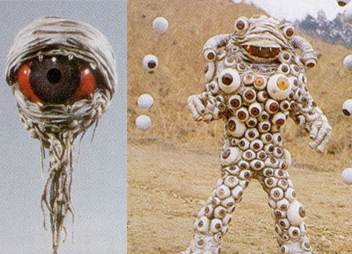
| #8 - Eye & Eye |
"Freaked" is a big-budget, 1993 comedy that has to be seen to be believed. Pulled from wide theatrical
distribution when executives literally found it "too weird," it featured a hilarious cast of mutants and
monstrosities including the descriptively named Sockhead (Bobcat Goldthwait with a sock puppet head), The
Hideous Frogman (literally a scuba diver), the Bearded Lady (Mr. T in drag) and even sillier (the hammer. The
poor hammer. Just find this film and watch it)... but the one detail everybody seems to remember - even when
the rest of the film is a delirious blur - are the brief performances by "Eye & Eye," a pair of security guards
under the villain's employ who just so happen to be not only giant eyeballs, but Rastafarian giant eyeballs.
distribution when executives literally found it "too weird," it featured a hilarious cast of mutants and
monstrosities including the descriptively named Sockhead (Bobcat Goldthwait with a sock puppet head), The
Hideous Frogman (literally a scuba diver), the Bearded Lady (Mr. T in drag) and even sillier (the hammer. The
poor hammer. Just find this film and watch it)... but the one detail everybody seems to remember - even when
the rest of the film is a delirious blur - are the brief performances by "Eye & Eye," a pair of security guards
under the villain's employ who just so happen to be not only giant eyeballs, but Rastafarian giant eyeballs.
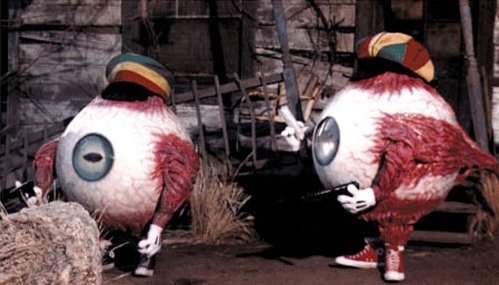
| #6 - Skipper |
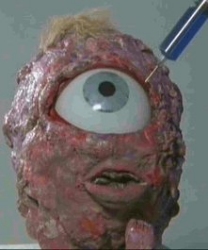
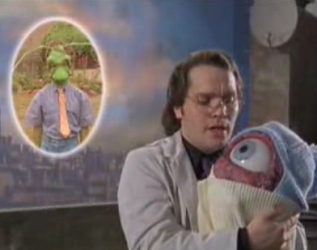
"Garth Marenghi's Dark Place" was an ambitious British comedy that originally aired in 2004 and was met with
less than adequate ratings, earning wider popularity only after ending with a meager six episodes. A clever
parody of sci-fi horror serials, the program was presented as a "lost" horror series from the 1980's, carefully
crafted to look authentically low-budget, poorly written and inconsistent.
In "Skipper the Eye Child," the third and most popular episode, a human man is assaulted by a giant eyeball
creature and gives birth to its offspring, a violent little beast that one of the doctors adopts as his own. In
multiple flashbacks and a brief musical sequence, we learn that he once had a real son - a mutant insect-boy
- who died in a freak accident. Naturally, Skipper is a bloodthirsty killer, which his surrogate father refuses to
accept.
less than adequate ratings, earning wider popularity only after ending with a meager six episodes. A clever
parody of sci-fi horror serials, the program was presented as a "lost" horror series from the 1980's, carefully
crafted to look authentically low-budget, poorly written and inconsistent.
In "Skipper the Eye Child," the third and most popular episode, a human man is assaulted by a giant eyeball
creature and gives birth to its offspring, a violent little beast that one of the doctors adopts as his own. In
multiple flashbacks and a brief musical sequence, we learn that he once had a real son - a mutant insect-boy
- who died in a freak accident. Naturally, Skipper is a bloodthirsty killer, which his surrogate father refuses to
accept.
| #5 - Roger the Monster |
There's a whole story behind Roger and I, but I'll leave that in its own page. Roger was created for the
award-winning, ultra-crazy children's program, "Pee Wee's Playhouse," and debuted in the episode "Monster
in the Playhouse," a heartwarming little story that stressed respect for the unusual and different. With a single
foot, suckered arms, dual mouths and weird, dangling hoses, this six-foot cyclops is one of the most truly alien
entities to ever be written as a lovable children's show guest, and his 20-something minutes of fame were a
major influence on my entire childhood.
award-winning, ultra-crazy children's program, "Pee Wee's Playhouse," and debuted in the episode "Monster
in the Playhouse," a heartwarming little story that stressed respect for the unusual and different. With a single
foot, suckered arms, dual mouths and weird, dangling hoses, this six-foot cyclops is one of the most truly alien
entities to ever be written as a lovable children's show guest, and his 20-something minutes of fame were a
major influence on my entire childhood.
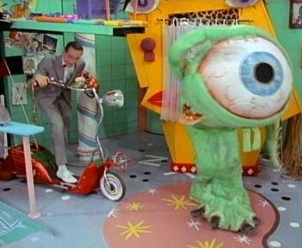
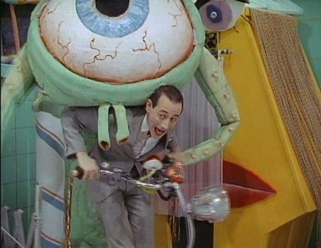
| #4 - The Killer Eye |
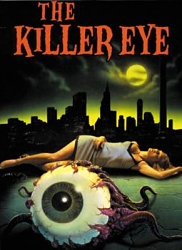
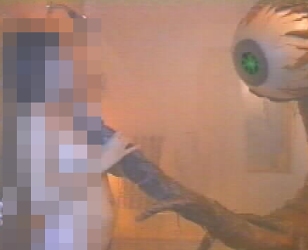
Arriving straight to video in 1999, this low-budget horror production brings us the sleaziest eyeball on the list.
When a teenager peers through an experimental scope, he gets an eyeful of the "eighth dimension" - literally
- and his eyeball frees itself from the dying boy's skull as it develops a mind of its own and grows to monstrous
proportions. Suspended on a single, massive tentacle (contrary to the cover art), the "Killer eye" stalks human
women and combines hypnotic powers with said tentacle to the only obvious ends that a woman-stalking
monster would ever combine the two. By the time the eye is sent back to his plane of reality, the entire female
cast is already pregnant; presumably with the next generation of eyeballs or perhaps a breed of
eyeball-human hybrids, implying a sequel that would never be made.
While not very famous, this strangely endearing pervert makes #4 as one of the few bodiless eyes to get a
starring movie role.
When a teenager peers through an experimental scope, he gets an eyeful of the "eighth dimension" - literally
- and his eyeball frees itself from the dying boy's skull as it develops a mind of its own and grows to monstrous
proportions. Suspended on a single, massive tentacle (contrary to the cover art), the "Killer eye" stalks human
women and combines hypnotic powers with said tentacle to the only obvious ends that a woman-stalking
monster would ever combine the two. By the time the eye is sent back to his plane of reality, the entire female
cast is already pregnant; presumably with the next generation of eyeballs or perhaps a breed of
eyeball-human hybrids, implying a sequel that would never be made.
While not very famous, this strangely endearing pervert makes #4 as one of the few bodiless eyes to get a
starring movie role.
| #3 - Beholders |
Introduced in the original 1975 "Monster Manual," the Beholder is the single most recognized icon of the
"Dungeons and Dragons" roleplaying game and regarded as a symbol of fantasy gaming itself. Armed with a
grab-bag of dangerous rays and an anti-magic field, the intelligent, malevolent "eye tyrant" is a force for even
high-level characters to reckon with. Also dangerously xenophobic, the only thing a Beholder despises more
than a non-Beholder is another Beholder with so much as a different skin tone. Unfortunately for them, they
continue to spawn not only wild variants within the game world but so many imitators throughout popular
culture that they've run out of names. Dig through any dozen "RPG" titles and you're bound to find at least
one gazer, watcher, lookout, scryer, spyer, spy eye, bug eye, overseer, evil eye, oculus, optica, or I don't
know, maybe an eyehaver. Sheesh.
"Dungeons and Dragons" roleplaying game and regarded as a symbol of fantasy gaming itself. Armed with a
grab-bag of dangerous rays and an anti-magic field, the intelligent, malevolent "eye tyrant" is a force for even
high-level characters to reckon with. Also dangerously xenophobic, the only thing a Beholder despises more
than a non-Beholder is another Beholder with so much as a different skin tone. Unfortunately for them, they
continue to spawn not only wild variants within the game world but so many imitators throughout popular
culture that they've run out of names. Dig through any dozen "RPG" titles and you're bound to find at least
one gazer, watcher, lookout, scryer, spyer, spy eye, bug eye, overseer, evil eye, oculus, optica, or I don't
know, maybe an eyehaver. Sheesh.
Why, then, are these famous monsters only third in the list? Often drawn with fairly small eyes in proportion to
their bodies, I've always felt that Beholders skirt the line between proper "eyeball creature" and mere
"creature that has eyeballs," a distinction that should never be compromised and the same reason one Mike
Wazowski didn't make the list. If anything, most Beholders are best described as "floating head creatures."
their bodies, I've always felt that Beholders skirt the line between proper "eyeball creature" and mere
"creature that has eyeballs," a distinction that should never be compromised and the same reason one Mike
Wazowski didn't make the list. If anything, most Beholders are best described as "floating head creatures."
You see a massive, hovering sphere. Squirming eye-stalks sprout from its chitinous hide, and a single
massive eyeball protrudes above a slavering maw...
massive eyeball protrudes above a slavering maw...
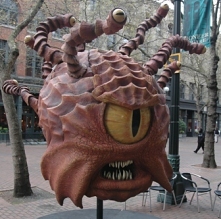
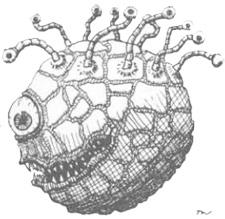
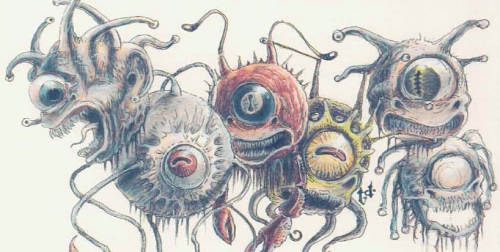
| #2 - Medama Oyaji |
Though obscure to us Westerners, there are probably few in Japan who wouldn't recognize old man eyeball,
omnipresent father of the celebrated children's hero, Kitarou. Once an undead mummy, he awakened for the
post-mortem birth of his son but had only one body part whole enough to house his spirit. Fortunately, Kitarou
has only a single eye of his own - leaving the other socket free for his dear old dad to travel in. Though tiny,
squeaky-voiced and adorable, Medama Oyaji is a worldly, caring, nearly indestructible role model to his
half-human son and an indispensable source of knowledge on the wide array of ghouls, ghosts, demons and
vampires the two are always tangling with. Plus, he drinks his favorite teas by bathing in them. Adorable!
omnipresent father of the celebrated children's hero, Kitarou. Once an undead mummy, he awakened for the
post-mortem birth of his son but had only one body part whole enough to house his spirit. Fortunately, Kitarou
has only a single eye of his own - leaving the other socket free for his dear old dad to travel in. Though tiny,
squeaky-voiced and adorable, Medama Oyaji is a worldly, caring, nearly indestructible role model to his
half-human son and an indispensable source of knowledge on the wide array of ghouls, ghosts, demons and
vampires the two are always tangling with. Plus, he drinks his favorite teas by bathing in them. Adorable!
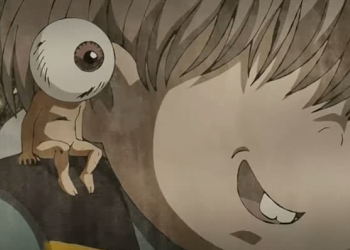
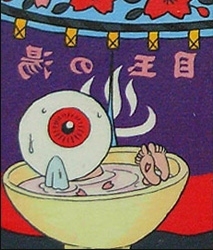

Even considering the geographic limit of his recognition, Medama Oyaji may very well be the most famous
disembodied eyeball in the world, with his likeness on at least half the kind of nonsense Hello Kitty can boast,
and if you're going to plaster the same character on toys, clothes, snacks, toiletries, USB flash drives,
religious shrines (yes, really) and motorized rubber pornography helmets (not really, but can you imagine?!),
you tell me why it shouldn't be the eye of a dead mummy.
disembodied eyeball in the world, with his likeness on at least half the kind of nonsense Hello Kitty can boast,
and if you're going to plaster the same character on toys, clothes, snacks, toiletries, USB flash drives,
religious shrines (yes, really) and motorized rubber pornography helmets (not really, but can you imagine?!),
you tell me why it shouldn't be the eye of a dead mummy.
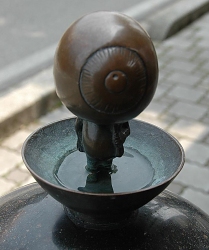
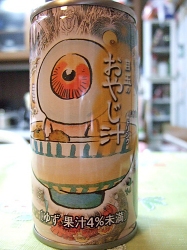
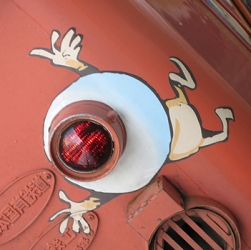
| The Crawling Eye |
1958's "The Crawling Eye" is one of the most famous sci-fi horror films of its era, and pop culture's most
formal introduction to the entire concept of a bodiless, living eyeball. They would surely be a common subject
with or without this piece of cinema, but this was their official debut in mainstream knowledge, and no doubt
left impressions on a whole generation of future monster artists. The titular "eyes," seen only in brief glimpses,
are invaders from a planet so alien that they only comfortably operate from the summit of a frozen mountain,
shrouded in a dense cloud of radioactive vapor. Capable of dominating human minds and tampering with
machinery, the eyes use their powerful tentacles to tear off - and presumably devour - only the heads of their
human prey, and are vulnerable only to heat.
"The Crawling Eye" was also featured in the very first episode of the beloved "Mystery Science Theater
3000," a long-running television comedy wherein a man and two delightful robots exchange sarcastic quips as
they "enjoy" a low-budget film.
formal introduction to the entire concept of a bodiless, living eyeball. They would surely be a common subject
with or without this piece of cinema, but this was their official debut in mainstream knowledge, and no doubt
left impressions on a whole generation of future monster artists. The titular "eyes," seen only in brief glimpses,
are invaders from a planet so alien that they only comfortably operate from the summit of a frozen mountain,
shrouded in a dense cloud of radioactive vapor. Capable of dominating human minds and tampering with
machinery, the eyes use their powerful tentacles to tear off - and presumably devour - only the heads of their
human prey, and are vulnerable only to heat.
"The Crawling Eye" was also featured in the very first episode of the beloved "Mystery Science Theater
3000," a long-running television comedy wherein a man and two delightful robots exchange sarcastic quips as
they "enjoy" a low-budget film.
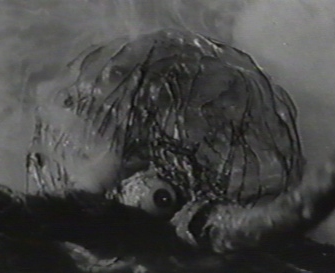
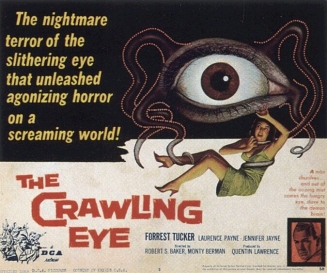

As you can see, eyeballs are only seldom given starring roles - even I had to dig to fill a list with truly
noteworthy examples - but the number of Z-list examples is through the roof; they're the glue that holds
together the anime demon horde, the incidental aliens that decorate bustling space ports, and the unnamed
stock monsters beaten up by heroes during musical montages.
noteworthy examples - but the number of Z-list examples is through the roof; they're the glue that holds
together the anime demon horde, the incidental aliens that decorate bustling space ports, and the unnamed
stock monsters beaten up by heroes during musical montages.
| By Jonathan Wojcik |
| #7 - Backbeard |
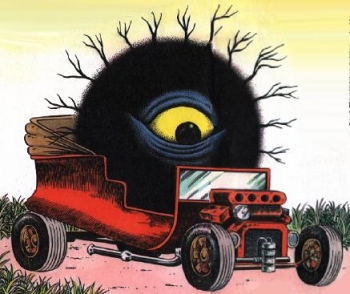
I've talked about the world of Mizuki Shigeru's Kitarou before, and you better believed I'll be talking about it
again before the end of this article, as this famous children's Manga and (multiple) animated series features
at least two prominent peepers - and one of them is its most fearsome villain. A fearsome villain with an
appreciation for vintage automobiles, it would seem. Whatever.
Most of the creatures faced by Kitarou hail from ancient Japanese folklore, but Backbeard is described by
Shigeru as a "Western-style" monster inspired by Celtic folklore. He's never been too clear on the details, but
it would seem that the name "Backbeard" is a cute mangling of such terms as Bugbear, Bugaboo, Boggart
and Bogeyman - various indistinct terms for creatures of pure terror and evil that prey upon children. This
particular Bogeyman fancies himself a sort of monster emperor, repeatedly attempting to subjugate the
goblins and specters of Japan with his vast army of minions - including Frankenstein's monster, Dracula,
Medusa, the Wolfman, witches, mummies and more.
Bizarrely, Backbeard has gone down in the footnotes of internet history as one of the more obscure running
jokes of communities such as 4chan. Long and confusing story short, the internet has officially decided that
Backbeard is the enemy of all pedophiles. There's nothing I can say here that can adequately explain why this
was decided, but Godspeed, Backbeard. Godspeed.
again before the end of this article, as this famous children's Manga and (multiple) animated series features
at least two prominent peepers - and one of them is its most fearsome villain. A fearsome villain with an
appreciation for vintage automobiles, it would seem. Whatever.
Most of the creatures faced by Kitarou hail from ancient Japanese folklore, but Backbeard is described by
Shigeru as a "Western-style" monster inspired by Celtic folklore. He's never been too clear on the details, but
it would seem that the name "Backbeard" is a cute mangling of such terms as Bugbear, Bugaboo, Boggart
and Bogeyman - various indistinct terms for creatures of pure terror and evil that prey upon children. This
particular Bogeyman fancies himself a sort of monster emperor, repeatedly attempting to subjugate the
goblins and specters of Japan with his vast army of minions - including Frankenstein's monster, Dracula,
Medusa, the Wolfman, witches, mummies and more.
Bizarrely, Backbeard has gone down in the footnotes of internet history as one of the more obscure running
jokes of communities such as 4chan. Long and confusing story short, the internet has officially decided that
Backbeard is the enemy of all pedophiles. There's nothing I can say here that can adequately explain why this
was decided, but Godspeed, Backbeard. Godspeed.